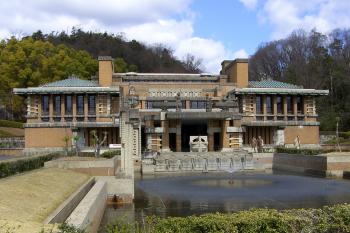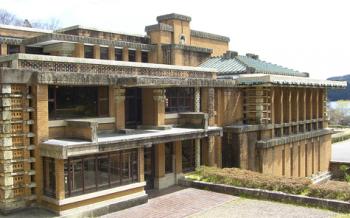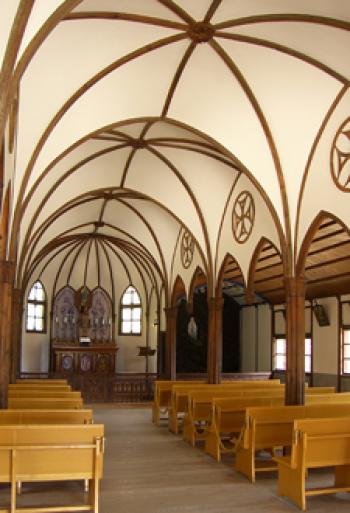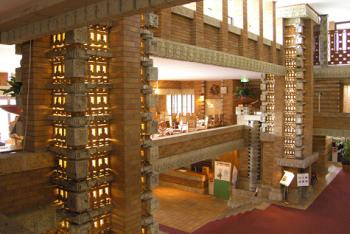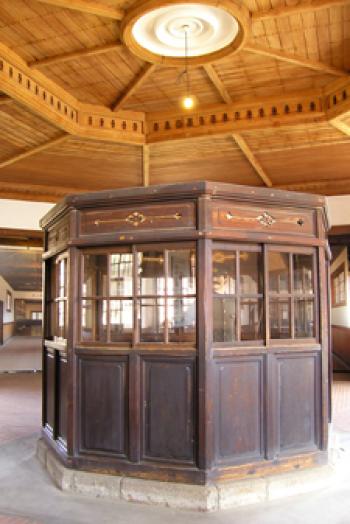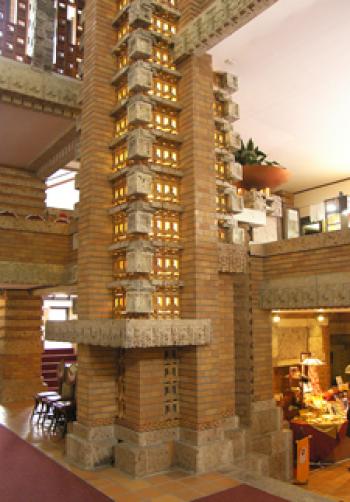Frank Lloyd Wright at Meiji-mura
This item appears on page 28 of the November 2018 issue.
On a day trip from Nagoya during our March-April 2016 sakura (cherry blossom) trip to Japan, my husband, Clyde, and I headed to Inuyama and its open-air architectural Museum Meiji-mura (www.meijimura.com/english). Our target was Frank Lloyd Wright's Imperial Hotel.
The museum site encompasses 60 cultural properties that were saved from planned demolition and reconstructed in a lovely, 250-acre setting. The structures date from 1867 to 1989 — the Meiji, Taisho and Shōwa periods.
The Imperial Hotel was built in Tokyo in 1923, and its partial demolition and disassembly were completed in 1968. It is a splendid structure and well worth as much time as you can put into it.
We found that the least expensive option for this day trip was to purchase a one-day package (the current price is ¥3,800 [near $34] per person), available from Nagoya's Meitetsu station.
Our package included round-trip train fare to the Inuyama Meitetsu Station (30 minutes from Nagoya), the Meitetsu bus from the station to Meiji-mura (20 minutes), unlimited use of the retro bus at the museum (different rules and limitations applied for the steam train and the trolley) and a snack.
We were able to purchase the ticket package a day in advance so we could get an early start the next day. The ticket sales office is on a lower level in the station; a few directional signs and volunteer guides help travelers find their way around. The agent who helped us spoke little English, but she offered us a pamphlet showing the options for traveling to Meiji-mura.
•
We arrived at the museum entrance gate before opening time and were first in line. (The day we went, the gate opened at 9:30 a.m., but check the website, since opening dates and times are seasonal.)
Once the ticket booth opened, we exchanged our redemption vouchers for museum entry tickets and retro bus tickets. The process was made easy by the English-speaking agent and the handy information sheet we were offered at the ticket booth that explained our options.
We recommend choosing the retro bus, since its use was unlimited. It stopped at more sites than either the train or the trolley.
We hopped the first bus for a 20-minute ride to the Imperial Hotel from the retro bus stop in front of the entrance booth. We got an overview of the grounds on the bus ride.
More importantly, we got to photograph the exterior and much of the interior of the hotel before the crowds arrived. The building is one of the main draws at the museum, and, as the morning progressed, it got more and more crowded.
Only the reflecting pool, entrance and central lobby to the hotel have been reconstructed at the museum; the rest of the building is gone. But what a pool, what an entrance and what a lobby! The whole hotel must have been a magnificent pile.
Near the end of our visit, we stopped for coffee and cake at the little tearoom on the mezzanine over the entrance. We weren't hungry, but it seemed like the right thing to do.
However, two "cake sets" (a slice of cheesecake and a coffee) at ¥950 each seemed like too much food and too pricey for a whim. We decided that one of us would order a slice of cheesecake and one a coffee and then share. At a total cost of ¥1,000, it would perhaps justify our taking up two chairs.
Before we were served, we took the opportunity to photograph from the mezzanine, getting yet another vantage point for our photos of the hotel's interior. The sweet little ladies who ran the place were so moved, either by our obvious devotion to the building or by our careful calculations about the costs of a treat, they charged us only ¥950, as if we'd had just one cake set. In addition, they gave us a plate of mini-pancakes — a daily special — with a cup of coffee! (Note that the tea break is not included in the admission ticket.)
Even if you aren't hungry, you can't pass up this opportunity, just to be able to say you did it! And taking a moment to sit quietly and absorb the building is a wonderful way to break the tourist slog.
•
After spending about two hours at the Imperial Hotel, we were ready to take on the rest of the huge complex. It was good that we had previously studied and copied site maps and brochures from online sources so we could prioritize what we wanted to visit.
If you plan conservatively, in a very full day you can see everything in which you're interested. You do have to be willing to ride the bus past buildings you won't have time to visit, just looking at them in passing.
Walking in one area, we bogged down on a succession of interesting buildings: a rescued jail, banks and other municipal buildings, the odd koban (police station), a bridge, a telephone exchange and an old post office. We took many photos at St. Paul Daimyoji Church and St. Francis Xavier Cathedral.
We walked by and looked into a bathhouse, a theater with a revolving stage, the expatriate writer Lafcadio Hearn's summer house (which has been turned into a trinket/souvenir shop) and an abutting barber shop.
Our admission ticket included a snack — curry bread and a cola, enough to stave off hunger — which we picked up at one of the many stands scattered around the park. There were other food options available or we could have brought along a snack.
We walked from the food stall up a street, where we saw sake breweries and a merchant's house, a school with an auditorium and a chemistry/physics building, a doctor's office and a district office. On this street, several families with young children were using a modern playground, but music from a blaring loudspeaker intruded on the otherwise-quiet setting.
We left and walked onto a bluff overlooking the lake for some nice views. We also stopped at a pharmaceutical institute and a prince's villa.
At this point, we were tired and had had enough. We took the retro bus back to the entrance, retraced our way back to the station and returned to Nagoya.
•
Here are a few site-visiting tips.
Senior discounts are available at the gate but are not available with the package tour ticket at the train station. Our math showed us that the package deal was better than getting the senior discount and separate tickets for everything else.
Arrive as early as possible, but, even then, there is too much to see in one full day.
Snap a shot of or copy down the bus schedule for the train station; this was posted on a sheet attached to a pole at the bus stop near the entrance. Not many buses run each hour. Plan to return to the entrance close to the arrival time of the bus so you don't waste sightseeing time waiting for the next bus.
Toilets are strategically and discreetly placed throughout the park. For example, once you exit the hotel, if you walk to your left around the reflecting pool, you'll come upon a toilet building.
If you're looking for another day trip from Nagoya, Inuyama is the site of one of only 12 original castles left standing in Japan: Inuyama Castle. It's a tiny castle that is often described as the oldest in the country. Nearby are two shrines to make your visit complete.
If it is sakura season, so much the better, since the walk from the station to the castle is lined with cherry trees along the river.
JANE B. HOLT
Hinesburg, VT

